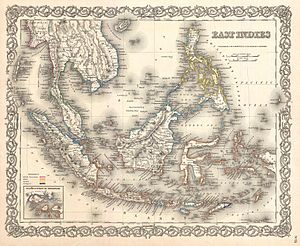Names of Indonesia
On identifying geographical names of their lands, the Indonesian natives seldom transcend their traditional boundaries, which is relatively small confined in their tribal environs.
There are around 1,300 distinct native ethnic groups in Indonesia, and 742 different languages,[1][2] which add to the complexity and nonconformity on the naming of the region.
It was foreign traders and explorers from India, China, the Middle East, and Europe who finally chose the names of this region.
It was mentioned that Sugriva, the chief of Rama's army, dispatched his men to Yawadvipa, the island of Java, in search of Sita.
Iabadiu is said to mean "barley island", to be rich in gold, and have a silver town called Argyra at the west end.
[7][8] "Jawah" and "Jawi" may have been used by the Arabs as catch-all terms referring to the entire Maritime Southeast Asia and its peoples.
Nanyang (南洋) (literally meaning "Southern Ocean"), is a Chinese term denoting the greater Maritime Southeast Asia region not only Indonesia, but also including Malaysia, Philippines, Singapore, and Brunei, but usually excluding other mainland Southeast Asian nations, especially the other nations on the Indochinese peninsula.
Insulindia or Insulinde, is an archaic geographical term[10][11][12] for Maritime Southeast Asia, encompassing the entire area situated between Australasia and Indochina.
Gajah Mada delivered an oath called Sumpah Palapa, in which he vowed not to eat any food containing spices until he had conquered all of Nusantara under Majapahit.
The term "the Indies" derived from the Indus River flowing through modern-day Pakistan, India and western Tibet.
[27] After 1900, the name Indonesia became more common in academic circles outside the Netherlands, and Indonesian nationalist groups adopted it for political expression.
[27] Adolf Bastian, of the University of Berlin, popularised the name through his book Indonesien oder die Inseln des Malayischen Archipels, 1884–1894.
The first Indonesian scholar to use the name was Suwardi Suryaningrat (Ki Hajar Dewantara), when he established a press bureau in the Netherlands, Indonesisch Pers-bureau, in 1913.
Although the name was originally meant for scientific purposes, on 28 October 1928, the name "Indonesia" gained more political significance when the native pro-independence nationalist youth in the Dutch East Indies declared the Youth Pledge, acknowledging Indonesia as one motherland, one nation, and upholding Indonesian as the language of unity.
It was originally from the Dutch phrase Gordel van Smaragd ("Emerald of the Tropic") which coined by Multatuli (a pen name used by Eduard Douwes Dekker, a 19th-century Dutch writer, who described Dutch East Indies as "'t prachtig ryk van Insulinde dat zich daar slingert om den evenaar, als een gordel van smaragd" ("the beautiful empire of Insulinde that girdles the equator like a belt of emerald").
[30] Other local epithets such as Bumi Pertiwi ("Land of Earth or Mother Earth"), refer to Indonesia through its national personification, Ibu Pertiwi, and Tanah Air (Indonesian lit: "soil and water"), an Indonesian word for "homeland", motherland, or mother country.


